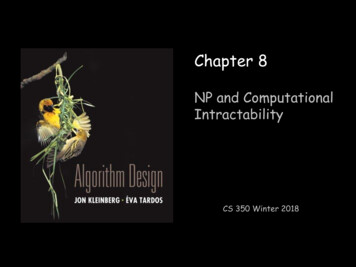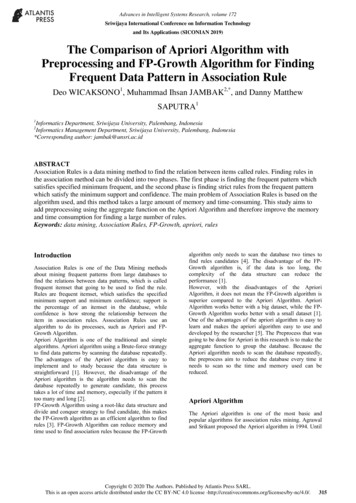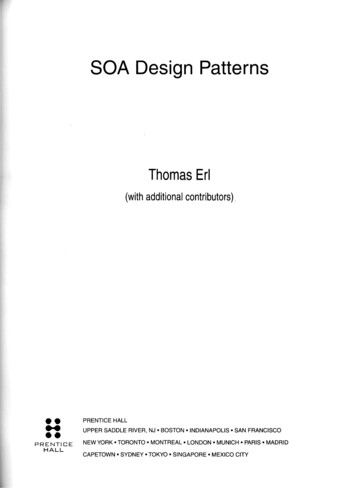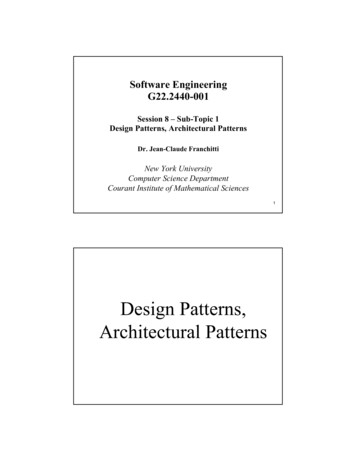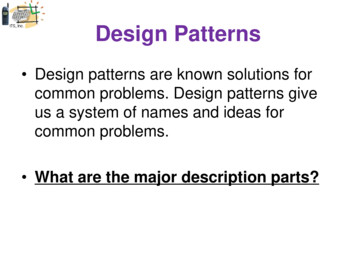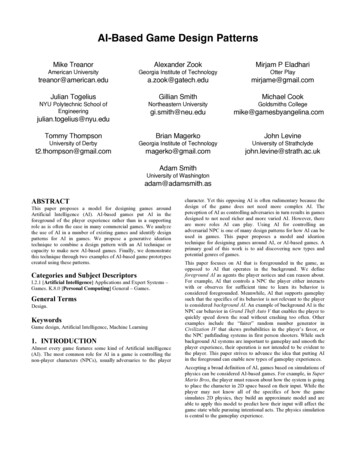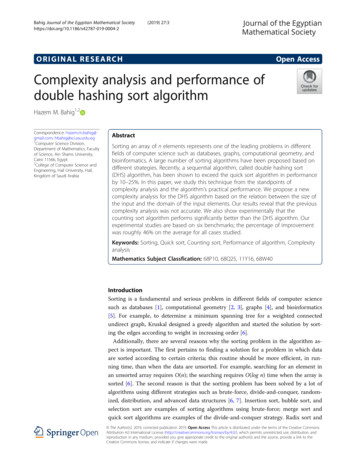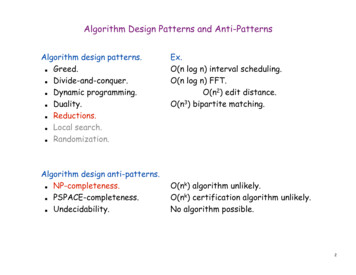
Transcription
Algorithm Design Patterns and Anti-PatternsAlgorithm design patterns.Greed.Divide-and-conquer.Dynamic programming.Duality.Reductions.Local search.Randomization. Ex.O(n log n) interval scheduling.O(n log n) FFT.O(n2) edit distance.O(n3) bipartite matching. Algorithm design Undecidability. O(nk) algorithm unlikely.O(nk) certification algorithm unlikely.No algorithm possible.2
8.1 Polynomial-Time Reductions
Classify Problems According to Computational RequirementsQ. Which problems will we be able to solve in practice?A working definition. [Cobham 1964, Edmonds 1965, Rabin 1966]Those with polynomial-time algorithms.YesProbably noShortest pathLongest pathMatching3D-matchingMin cutMax cut2-SAT3-SATPlanar 4-colorPlanar 3-colorBipartite vertex coverVertex coverPrimality testingFactoring4
Classify ProblemsDesiderata. Classify problems according to those that can be solved inpolynomial-time and those that cannot.Provably requires exponential-time.Given a Turing machine, does it halt in at most k steps?Given a board position in an n-by-n generalization of chess, can blackguarantee a win? Frustrating news. Huge number of fundamental problems have defiedclassification for decades.This chapter. Show that these fundamental problems are"computationally equivalent" and appear to be different manifestationsof one really hard problem.5
Polynomial-Time ReductionDesiderata'. Suppose we could solve X in polynomial-time. What elsecould we solve in polynomial time?don't confuse with reduces fromReduction. Problem X polynomial reduces to problem Y if arbitraryinstances of problem X can be solved using:Polynomial number of standard computational steps, plusPolynomial number of calls to oracle that solves problem Y. Notation. X P Y.computational model supplemented by special pieceof hardware that solves instances of Y in a single stepRemarks.We pay for time to write down instances sent to black box instances of Y must be of polynomial size.Note: Cook reducibility. in contrast to Karp reductions6
Polynomial-Time ReductionPurpose. Classify problems according to relative difficulty.Design algorithms. If X P Y and Y can be solved in polynomial-time,then X can also be solved in polynomial time.Establish intractability. If X P Y and X cannot be solved inpolynomial-time, then Y cannot be solved in polynomial time.Establish equivalence. If X P Y and Y P X, we use notation X P Y.up to cost of reduction7
Reduction By Simple EquivalenceBasic reduction strategies. Reduction by simple equivalence. Reduction from special case to general case. Reduction by encoding with gadgets.
Independent SetINDEPENDENT SET: Given a graph G (V, E) and an integer k, is there asubset of vertices S V such that S k, and for each edge at mostone of its endpoints is in S?Ex. Is there an independent set of size 6? Yes.Ex. Is there an independent set of size 7? No.independent set9
Vertex CoverVERTEX COVER: Given a graph G (V, E) and an integer k, is there asubset of vertices S V such that S k, and for each edge, at leastone of its endpoints is in S?Ex. Is there a vertex cover of size 4? Yes.Ex. Is there a vertex cover of size 3? No.vertex cover10
Vertex Cover and Independent SetClaim. VERTEX-COVER P INDEPENDENT-SET.Pf. We show S is an independent set iff V - S is a vertex cover.independent setvertex cover11
Vertex Cover and Independent SetClaim. VERTEX-COVER P INDEPENDENT-SET.Pf. We show S is an independent set iff V - S is a vertex cover. Let S be any independent set.Consider an arbitrary edge (u, v).S independent u S or v S u V - S or v V - S.Thus, V - S covers (u, v). Let V - S be any vertex cover.Consider two nodes u S and v S.Observe that (u, v) E since V - S is a vertex cover.Thus, no two nodes in S are joined by an edge S independent set. 12
Reduction from Special Case to General CaseBasic reduction strategies. Reduction by simple equivalence. Reduction from special case to general case. Reduction by encoding with gadgets.
Set CoverSET COVER: Given a set U of elements, a collection S1, S2, . . . , Sm ofsubsets of U, and an integer k, does there exist a collection of k ofthese sets whose union is equal to U?Sample application.m available pieces of software.Set U of n capabilities that we would like our system to have.The ith piece of software provides the set Si U of capabilities.Goal: achieve all n capabilities using fewest pieces of software. Ex:U { 1, 2, 3, 4, 5, 6, 7 }k 2S1 {3, 7}S4 {2, 4}S2 {3, 4, 5, 6}S5 {5}S3 {1}S6 {1, 2, 6, 7}14
Vertex Cover Reduces to Set CoverClaim. VERTEX-COVER P SET-COVER.Pf. Given a VERTEX-COVER instance G (V, E), k, we construct a setcover instance whose size equals the size of the vertex cover instance.Construction.Create SET-COVER instance:– k k, U E, Sv {e E : e incident to v }Set-cover of size k iff vertex cover of size k. VERTEX COVERae7e2e3e4e6fk 2SET COVERbce5e1eU { 1, 2, 3, 4, 5, 6, 7 }k 2Sa {3, 7}Sb {2, 4}Sc {3, 4, 5, 6}Sd {5}Se {1}Sf {1, 2, 6, 7}d15
Polynomial-Time ReductionBasic strategies.Reduction by simple equivalence.Reduction from special case to general case.Reduction by encoding with gadgets. 16
8.2 Reductions via "Gadgets"Basic reduction strategies. Reduction by simple equivalence. Reduction from special case to general case. Reduction via "gadgets."
SatisfiabilityLiteral: A Boolean variable or its negation.xi or xiClause: A disjunction of literals.C j x1 x2 x3 Conjunctive normal form: A propositional formula Φ that is the conjunction of clauses.Φ C1 C2 C3 C4 SAT: Given CNF formula Φ, does it have a satisfying truth assignment?3-SAT: SAT where each clause contains exactly 3 literals.each corresponds to a different variableEx:( x1 x2 x3 ) ( x1 x2 x 3 ) ( x2 x3 ) ( x1 x2 x3 )Yes: x1 true, x2 true x3 false. 18
3 Satisfiability Reduces to Independent SetClaim. 3-SAT P INDEPENDENT-SET.Pf. Given an instance Φ of 3-SAT, we construct an instance (G, k) ofINDEPENDENT-SET that has an independent set of size k iff Φ issatisfiable.Construction.G contains 3 vertices for each clause, one for each literal.Connect 3 literals in a clause in a triangle.Connect literal to each of its negations. x2x1x1G x2x3k 3 Φ ( x1 x1x3 x2 x 3 ) ( x1 x2 x 3 ) x2x4( x1 x2 x 4 ) 19
3 Satisfiability Reduces to Independent SetClaim. G contains independent set of size k Φ iff Φ is satisfiable.Pf. Let S be independent set of size k.S must contain exactly one vertex in each triangle.and any other variables in a consistent waySet these literals to true.Truth assignment is consistent and all clauses are satisfied. Pf Given satisfying assignment, select one true literal from eachtriangle. This is an independent set of size k. x2x1x1G x2x3k 3 Φ ( x1 x1x3 x2 x 3 ) ( x1 x2 x 3 ) x2x4( x1 x2 x 4 ) 20
ReviewBasic reduction strategies.Simple equivalence: INDEPENDENT-SET P VERTEX-COVER.Special case to general case: VERTEX-COVER P SET-COVER.Encoding with gadgets: 3-SAT P INDEPENDENT-SET. Transitivity. If X P Y and Y P Z, then X P Z.Pf idea. Compose the two algorithms.Ex: 3-SAT P INDEPENDENT-SET P VERTEX-COVER P SET-COVER.21
Self-ReducibilityDecision problem. Does there exist a vertex cover of size k?Search problem. Find vertex cover of minimum cardinality.Self-reducibility. Search problem P decision version.Applies to all (NP-complete) problems in this chapter.Justifies our focus on decision problems. Ex: to find min cardinality vertex cover.(Binary) search for cardinality k* of min vertex cover.Find a vertex v such that G - { v } has a vertex cover of size k* - 1.– any vertex in any min vertex cover will have this propertyInclude v in the vertex cover.Recursively find a min vertex cover in G - { v }. delete v and all incident edges22
Algorithm design patterns. Ex. . Primality testing Factoring Planar 4-color Planar 3-color Bipartite vertex cover Vertex cover . 5 Classify Problems Desiderata. Classify problems according to those that can be solved in . computational model supplemented by special piece of hardware that solves instances of Y in a single step

